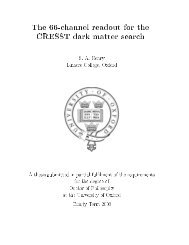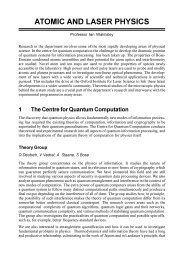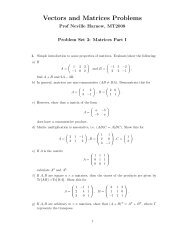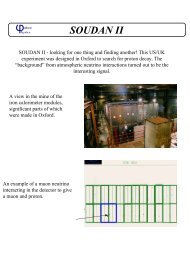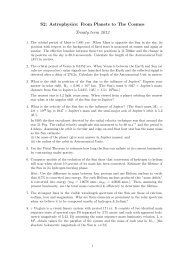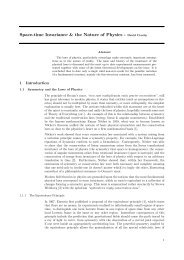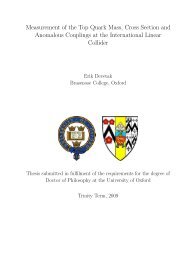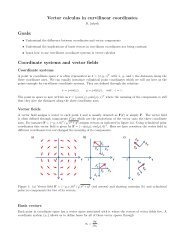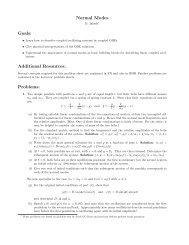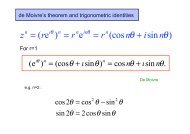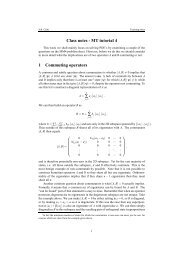Create successful ePaper yourself
Turn your PDF publications into a flip-book with our unique Google optimized e-Paper software.
Frictional losses across turbine blades vary like u 2 (F D =½C D ρAu 2 )<br />
ie very large for large u (near speed <strong>of</strong> sound)<br />
Losses reduced significantly by using many stages in series (~50 stages)<br />
Other practical effects limiting efficiency<br />
The loss <strong>of</strong> kinetic energy at each stage is<br />
small and turbulence is reduced<br />
a) Boiler tubes have finite thickness, so outer wall temperature is higher<br />
than <strong>water</strong>/steam temperature<br />
b) Metallurgical limit to temperature/pressure difference boiler tubes<br />
can withstand (creep/crack formation)<br />
c) Many pipes/tubes in flow circuit frictional losses<br />
d) Condenser is a vacuum chamber air leaks in but can not condense,<br />
so ‘air blanket’ forms, preventing <strong>water</strong> vapour from condensing on<br />
cold surface <strong>of</strong> condenser tubes<br />
T<br />
W 12<br />
2<br />
1<br />
3<br />
Q 23<br />
W 34<br />
Q 41<br />
4<br />
Efficiency <strong>of</strong> Rankine Cycle<br />
S<br />
Condenser at 30 C at a pressure <strong>of</strong> 0.04 bar<br />
Compressor increases pressure to 170 bar<br />
Three-stage boiler at 170 bar<br />
a) economiser raises temperature to 352 C<br />
b) evaporator at 352 C<br />
c) superheater raises temperature to 600 C<br />
Adiabatic turbine<br />
T p h f h g s f s g<br />
Water/Steam 30 0.04 126 2566 0.436 8.452<br />
Water/Steam 352 170 1690 2548 3.808 5.181<br />
Dry Steam 600 170 3564 6.603<br />
where h f and h g are the specific enthalpies and s f and s g are the<br />
specific entropies <strong>of</strong> the fluid and gas, respectively, in kJ/kg.<br />
Adiabatic compression or expansion<br />
W = W s + (p 1 v 1 − p 2 v 2 ) = ∆U = u 2 − u 1<br />
W s = (u 2 − u 1 ) − (p 1 v 1 − p 2 v 2 )<br />
= (u 2 + p 2 v 2 ) − (u 1 + p 1 v 1 )<br />
= h 2 − h 1<br />
Work done by the shaft W s<br />
on the fluid<br />
Adiabatic so Q = 0<br />
Total work W<br />
First Law: ∆U = Q + W<br />
Note sign convention<br />
In adiabatic process work done equals change in enthalpy<br />
Specific enthalpy h = u +pv; dh = TdS + Vdp<br />
isobaric, constant pressure, dh = du + pdv = dQ<br />
isentropic dh = dW = Vdp<br />
i) W 12 = V(p 2 − p 1 ) = 10 −3 (170 − 0.04) 10 5<br />
=17 kJ/kg 3<br />
ii) 12 isentropic so<br />
h 2 = h 1 + W 12 = 126 + 17 = 143 kJ/kg<br />
iii) 23 isobaric so<br />
Q 23 = h 3 – h 2 = 3564 − 143 = 3421 kJ/kg<br />
iv) 34 isentropic so<br />
W 34 = h 3 – h 4 and s 3 = s 4<br />
s 4 = (1−x)s f4 + xs g4<br />
s 3 = 6.603 = (1−x)0.436 + 8.452 x<br />
x = 0.769<br />
T<br />
W 12<br />
2<br />
1<br />
Q 23<br />
W 34<br />
Q 41<br />
4<br />
S




